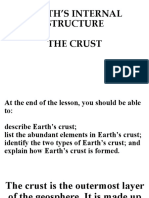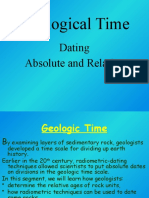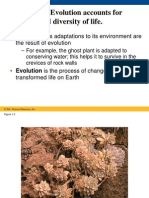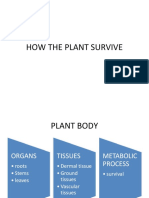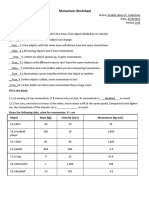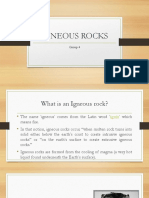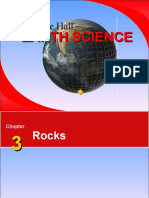Layers of The Earth
Layers of The Earth
Uploaded by
torebsuicoCopyright:
Available Formats
Layers of The Earth
Layers of The Earth
Uploaded by
torebsuicoOriginal Description:
Original Title
Copyright
Available Formats
Share this document
Did you find this document useful?
Is this content inappropriate?
Copyright:
Available Formats
Layers of The Earth
Layers of The Earth
Uploaded by
torebsuicoCopyright:
Available Formats
LAYERS OF THE EARTH
Earth comprises four separate layers. Geologists believe that as the Earth cooled, the heavier and
denser material sank into the centre, and the lighter ones rose towards the top. Due to this, the
outermost layer is made of the lightest materials, such as rocks and granites, and the innermost
layer consists of nickel and iron. Let’s discuss the different layers of the earth.
Different Layers of the Earth
The inner core, the outer core, mantle and crust are the four layers of earth
The Inner Core
It is the centre and the hottest layer of the Earth. The inner core is solid and made up of iron and
nickel with temperatures up to 5,500oC. Due to its immense heat energy, the inner core is more
like the engine room of the Earth.
The Outer Core
The outer core of the Earth is similar to a very hot ball of metals, whose temperature is around
4000 oF to 90000F. It is so hot that the metals inside are all liquid. The outer core is around 1800
miles under the crust and is approximately 1400 miles thick. It is composed of metals such as
iron and nickel. The outer core surrounds the inner core.
The inner core has pressures and temperatures so high that the metals are squeezed together and
not able to move like a liquid but are forced to vibrate instead of solid.
Mantle
Mantle is the widest section of the Earth. Its thickness is approximately 2,900 km. The mantle is
mainly made up of semi-molten rock known as magma. The rock is hard in the upper part of the
mantle, but lower down the rock is softer and begins to melt.
The mantle is located directly under the Sima. The mantle consists of very hot and dense rock.
This layer of rock flows like asphalt under heavy weight. This flow is because of the greatest
temperature differences from the bottom to the top of the mantle. The reason behind the plates of
the Earth moving is the movement of the mantle. Its temperature varies between 1600 oF at the
upper part to 4000 oF near the bottom.
Crust
The crust is the outer layer where we live. The thickness is around 0-60 km. It’s a solid rock
layer divided into two types:
1. Continental crust covers the land and,
2. Oceanic crust covers water
The crust is the most widely studied and understood. The mantle is hotter and capable of
flowing. The outer and inner core is much hotter with great pressures that you can squeeze into a
ball smaller than marble if you are able to go to the centre of the Earth.
You might also like
- Unit 1 Performance Task - Monument Mayhem, Part 1Document2 pagesUnit 1 Performance Task - Monument Mayhem, Part 1JACK CAMPBELL67% (3)
- Folding and Falting - Chapter 4Document9 pagesFolding and Falting - Chapter 4ellahbrackenNo ratings yet
- Four Subsytems of The EarthDocument31 pagesFour Subsytems of The EarthJenny-Lyn Duran100% (1)
- Earth SubsystemDocument6 pagesEarth SubsystemXenia Mae FloresNo ratings yet
- Lesson 02: Earths Subsystem.Document22 pagesLesson 02: Earths Subsystem.Yreal PangilinanNo ratings yet
- Grade11 Internal HeatDocument3 pagesGrade11 Internal Heatyekcimhadjiamer100% (1)
- HabitableEarth PPT With Guided NotesDocument12 pagesHabitableEarth PPT With Guided NotesKeanna AstrologNo ratings yet
- Geologic Time ScaleDocument12 pagesGeologic Time ScaleTwinkle B. Esteves100% (1)
- Periods of The Paleozoic Era: Cambrian PeriodDocument8 pagesPeriods of The Paleozoic Era: Cambrian PeriodChinatsu HayashidaNo ratings yet
- Lesson1 - Big Bang Theory and Formation of Lighter Elements - Students'Document40 pagesLesson1 - Big Bang Theory and Formation of Lighter Elements - Students'teodorojohncarlo01No ratings yet
- Use This! Earth and Earth SystemDocument48 pagesUse This! Earth and Earth SystemPrincess Jaymee Suarez100% (2)
- Lesson 3 MagmaDocument57 pagesLesson 3 MagmaDave MeñosaNo ratings yet
- Earth and Its SubsystemsDocument9 pagesEarth and Its SubsystemsRalph EspejoNo ratings yet
- Earth's CrustDocument21 pagesEarth's CrustGraham John LuCenaNo ratings yet
- 2015-2016 EARTHS Dating MethodsDocument37 pages2015-2016 EARTHS Dating MethodsasdNo ratings yet
- Perpetuation of LifeDocument40 pagesPerpetuation of LifeDionne MagnoNo ratings yet
- Concept 1.1. Evolution Accounts For The Unity and Diversity of LifeDocument21 pagesConcept 1.1. Evolution Accounts For The Unity and Diversity of LifeGirish RaguvirNo ratings yet
- Layers of The EarthDocument34 pagesLayers of The EarthAlbert Bugas100% (1)
- Continental Drift Theory and Evidences That Support Continental Drift TheoryDocument11 pagesContinental Drift Theory and Evidences That Support Continental Drift TheoryChad Laurence Vinson CandelonNo ratings yet
- Continental Drift and Plate Tectonics Part 1Document5 pagesContinental Drift and Plate Tectonics Part 1Jakie UbinaNo ratings yet
- Chapter 03 - Cell Structure and FunctionDocument32 pagesChapter 03 - Cell Structure and FunctionMaryam Ali100% (1)
- Lesson 5. Endogenic ProcessesDocument24 pagesLesson 5. Endogenic ProcessesKaseylene CabansagNo ratings yet
- Drew McDonald - K - G - K - SCH - bWtuZWxsQHJlZ2lvbjE2Y3Qub3Jn - POGIL - Where - Are - Plate - Boundaries - Located - Pdf.kamiDocument7 pagesDrew McDonald - K - G - K - SCH - bWtuZWxsQHJlZ2lvbjE2Y3Qub3Jn - POGIL - Where - Are - Plate - Boundaries - Located - Pdf.kamidrew.mcdonaldNo ratings yet
- Lesson 1 Earth The Unique Planet and Its SubsystemDocument59 pagesLesson 1 Earth The Unique Planet and Its SubsystemSherie Mae Querubin LozadaNo ratings yet
- Fundamental Concepts of GeomorphologyDocument16 pagesFundamental Concepts of Geomorphologyaasmaparveen706No ratings yet
- Day 2 Origin of The UniverseDocument49 pagesDay 2 Origin of The Universeludivino escardaNo ratings yet
- Earth Science Lesson 2 New NormalDocument35 pagesEarth Science Lesson 2 New NormalKyra MacamNo ratings yet
- How The Plant SurviveDocument16 pagesHow The Plant SurvivedhonaNo ratings yet
- Lesson 2:: Origin of The First Life FormsDocument5 pagesLesson 2:: Origin of The First Life FormsBruth Powky100% (1)
- Powerpoint EarthDocument7 pagesPowerpoint Earthdivya babuNo ratings yet
- Earth Sci Final TermDocument7 pagesEarth Sci Final TermeuphoriaNo ratings yet
- Igneous RocksDocument15 pagesIgneous RocksRowelyn Bakeke100% (1)
- Our Unique Earth Earth SubsystemDocument19 pagesOur Unique Earth Earth SubsystemMaricarDimas100% (1)
- Earth and Life Science (NS001) WK1-8 - REVIEWERDocument12 pagesEarth and Life Science (NS001) WK1-8 - REVIEWERAleiah Tyrese PobleteNo ratings yet
- STEM 11 Lesson 1 Earth's Characteristics For LifeDocument8 pagesSTEM 11 Lesson 1 Earth's Characteristics For LifeAlfie AndoNo ratings yet
- Lesson 7 Earths Processes Earth ScienceDocument4 pagesLesson 7 Earths Processes Earth ScienceRazen SisonNo ratings yet
- Momentum Worksheet: True or False?Document3 pagesMomentum Worksheet: True or False?Kiel totsNo ratings yet
- The Basic Principles of The EcosystemDocument15 pagesThe Basic Principles of The EcosystemMarvin Melis100% (2)
- L9 & 10 - Water ResourcesDocument59 pagesL9 & 10 - Water ResourcesappleNo ratings yet
- Theories On The Origin of The UniverseDocument9 pagesTheories On The Origin of The UniverseMichael James A. DaligdigNo ratings yet
- The Theory of Plate TectonicsDocument4 pagesThe Theory of Plate TectonicsjhemzNo ratings yet
- Stratified RocksDocument26 pagesStratified RocksXyana Jezzy Alexzandra RebaulaNo ratings yet
- Chapter 2 Section 1 Organisms and Their RelationshipsDocument21 pagesChapter 2 Section 1 Organisms and Their RelationshipsDwayne CordesNo ratings yet
- The Internal Structure of The Earth g12Document13 pagesThe Internal Structure of The Earth g12Ayhen Manalo - RañesesNo ratings yet
- Classification of RocksDocument18 pagesClassification of RocksStrng Pnd100% (1)
- Igneous RocksDocument15 pagesIgneous RocksNaomi MatasNo ratings yet
- Earth As A Unique Planet Adn Four Subsystems of The EarthDocument89 pagesEarth As A Unique Planet Adn Four Subsystems of The EarthGeloNo ratings yet
- EarthsystemDocument23 pagesEarthsystemapi-26963416No ratings yet
- Group 4 Endogenic and Exogenic ProcessesDocument42 pagesGroup 4 Endogenic and Exogenic ProcessesPrincess PabualanNo ratings yet
- Geological Hazards Earthquake Volcanic Eruption EtcDocument18 pagesGeological Hazards Earthquake Volcanic Eruption EtcSeanNo ratings yet
- 4.2 Sedimentary RocksDocument19 pages4.2 Sedimentary Rockss.sfnxxNo ratings yet
- Activity 2 Rocks and MineralsDocument2 pagesActivity 2 Rocks and MineralsEdrian Lait100% (1)
- Earths SystemsDocument10 pagesEarths Systemsapi-551702375No ratings yet
- 1 Definition and Origin of MagmaDocument17 pages1 Definition and Origin of MagmaAtharNo ratings yet
- Prentice Hall: Earth ScienceDocument36 pagesPrentice Hall: Earth Sciencerapash2000No ratings yet
- Module 1 Lesson 3 MineralsDocument20 pagesModule 1 Lesson 3 MineralsMELANIE ZARATENo ratings yet
- Endogenic and Exogenic ProcessesDocument13 pagesEndogenic and Exogenic ProcessesJohndee Mozart Dela CruzNo ratings yet
- Rock Layers ActivityDocument3 pagesRock Layers ActivityJongseong ParkNo ratings yet
- Three Layers of The Earth (Earth Science)Document6 pagesThree Layers of The Earth (Earth Science)mary joy v, chiquilloNo ratings yet
- Layer of The EarthDocument2 pagesLayer of The EarthJungkook RiegoNo ratings yet













